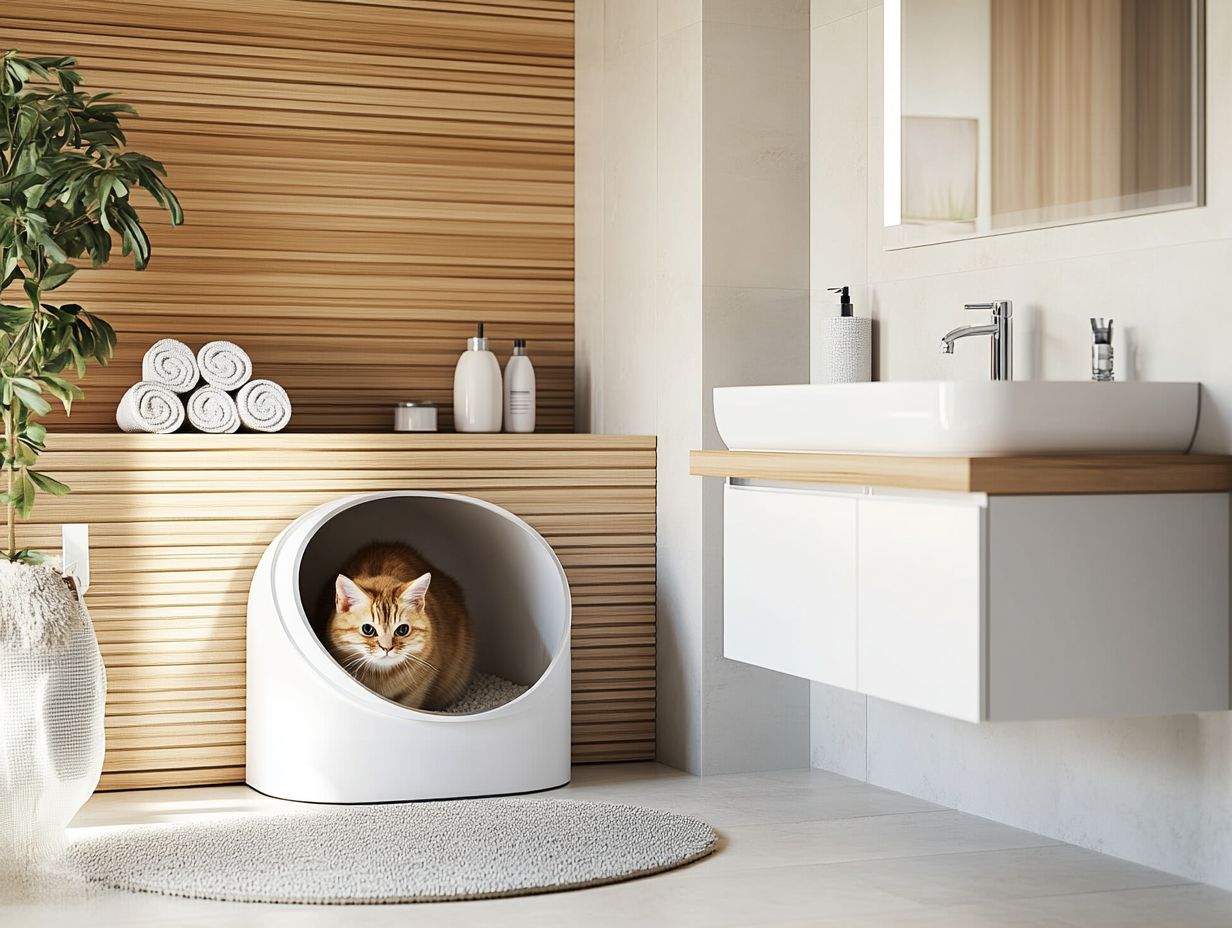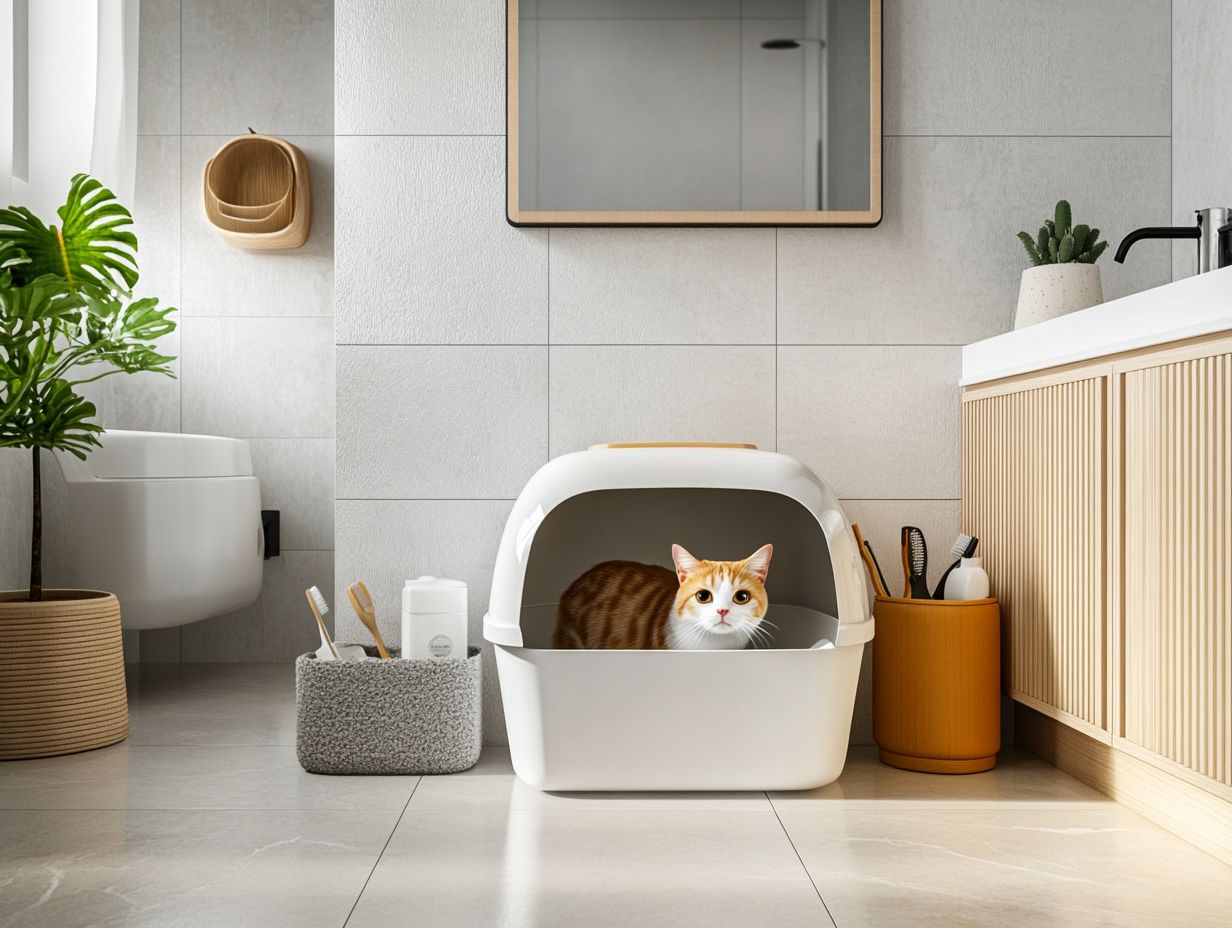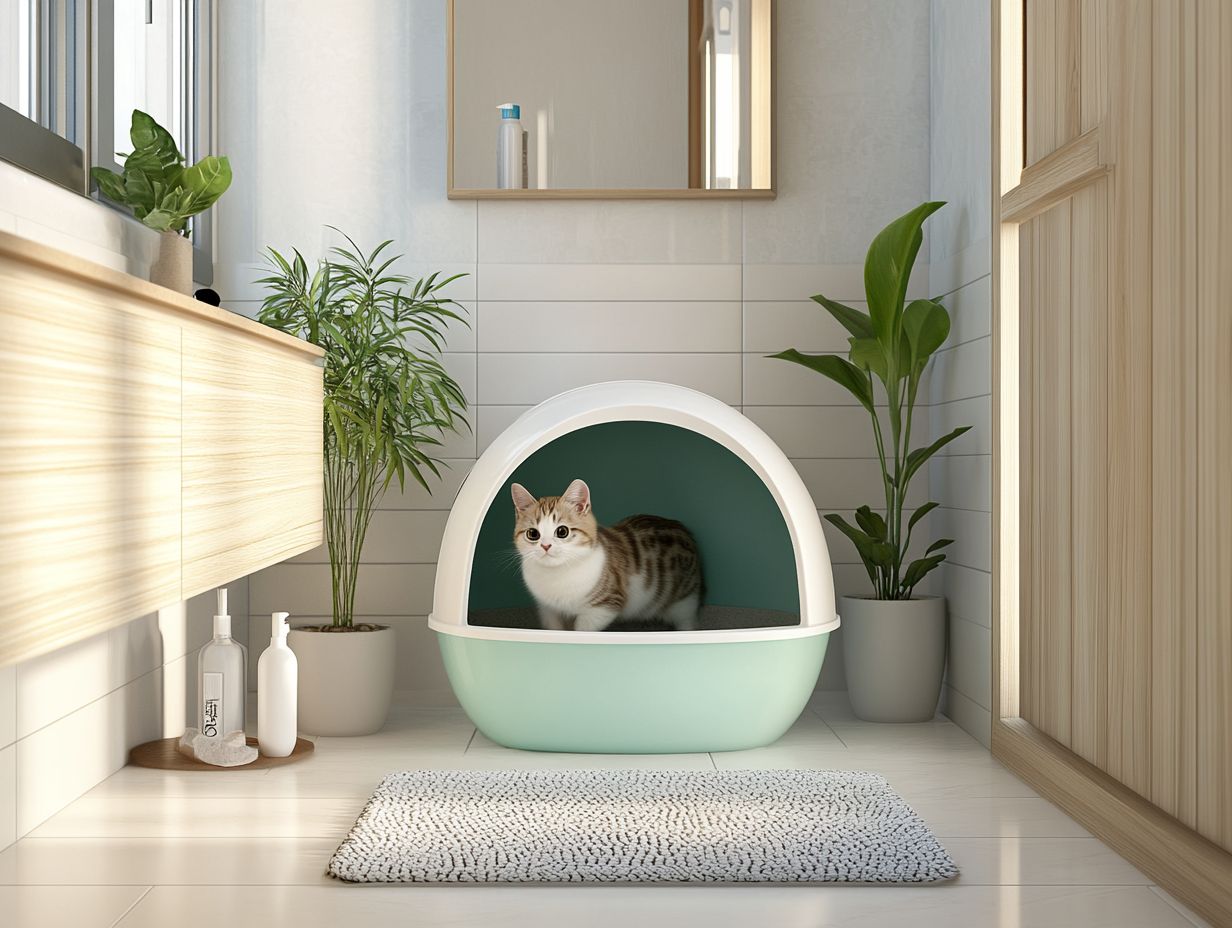If you’re a cat owner, managing litter box odors and maintaining a hygienic litter box environment can be a challenge.
Many cat owners find covered litter boxes effective for controlling odors and keeping the litter area cleaner. The Frisco High-Sided Cat Litter Box is a popular solution that aims to tackle these issues. But do they really deliver on their promises?
This article explores how covered litter boxes work, their effectiveness in odor control and cleanliness, and any downsides to consider.
Additionally, we will guide you in selecting the perfect covered litter box, considering your cat’s preferences and indoor needs.
Key Takeaways:

- Covered litter boxes can help control odor and keep the litter area cleaner for your cat.
- Choose a covered litter box with good ventilation, an easy-to-clean design, and suitable dimensions for optimal odor control.
- While they offer many benefits, covered litter boxes may require more maintenance and may not be suitable for all cats.
What Is a Covered Litter Box?
A covered litter box is designed to provide cats with privacy while effectively containing litter tracking and odors. These litter boxes are popular among cat owners because they address several issues commonly associated with litter box use.
Covered litter boxes are available in various styles, including high-sided and hooded designs. When choosing the best type for your indoor feline, consider their urinary behavior and overall comfort.
Do Covered Litter Boxes Help with Odor Control?
Many cat owners find these boxes effective for controlling odors because they help contain the smell of cat waste within a closed environment.
Many covered litter boxes come equipped with features like carbon filters, which absorb unpleasant smells, and self-cleaning functions that simplify maintenance.
Understanding the impact of litter box odors on cat health and behavior helps you make informed decisions when selecting options.
How Does a Covered Litter Box Reduce Odor?
A covered litter box reduces odors by enclosing waste and isolating it. These boxes are frequently used with carbon filters that neutralize smells, trapping odor molecules and significantly reducing bad smells.
Regular maintenance, including cleaning and changing filters, is essential for optimal effectiveness and to ensure a healthy environment for pets and caretakers alike.
Benefits of Covered Litter Boxes
The best covered litter boxes for odor control feature automatic cleaning systems, high-quality materials, and efficient ventilation designs that facilitate superior odor management.
Popular choices include the Litter-Robot 4 and the Frisco High-Sided Cat Litter Box, known for their effective odor control capabilities. The Catit Jumbo Hooded Cat Litter Pan offers an extra-large capacity and a built-in carbon filter for enhanced odor protection.
Another noteworthy option is the PetFusion BetterBox, which combines modern aesthetics with a high-sided design to prevent litter scatter, while airtight seals help contain odors.
Potential Drawbacks
While covered litter boxes can be beneficial, they may require more maintenance compared to open boxes, and some cats may feel confined or stressed by the enclosed space.
Do Covered Litter Boxes Help with Cleanliness?

For optimal results, clean the litter box at least once a day and change the litter regularly. Transitioning your cat to a covered litter box can be done gradually, allowing them to adjust to the new environment.
Conclusion
Covered litter boxes can be effective in managing odors and maintaining cleanliness, but it’s essential to choose the right one for your cat’s needs. Consider the benefits and potential drawbacks, and follow proper maintenance practices. By doing so, you can create a comfortable and clean space for your feline friend.
Covered litter boxes are designed to promote cleanliness in multi-cat households by containing litter and waste. These boxes come equipped with features that facilitate maintenance, including removable liners and easy-access lids. It’s crucial to verify claims about the benefits of covered litter boxes with reputable sources, such as veterinarians.
It’s also important to consider how covered litter pans interact with cats’ natural preferences for litter box types and cat care needs when selecting the right product for your feline family. Remember to have one litter box per cat plus one extra for optimal convenience.
How Does a Covered Litter Box Keep the Area Cleaner?
A covered litter box helps maintain a cleaner environment because its design contains the litter and prevents the tracking that often occurs with open boxes. The enclosed structure ensures that loose litter does not spill outside, keeping it contained for easier cleaning.
Additional features, such as high sides and lids, minimize mess outside the box. Many covered options also come with helpful mats or built-in filters that capture stray litter particles and unpleasant odors.
Various entrance designs encourage cats to enter and exit without dislodging litter outside the box.
Top Covered Litter Boxes for Maintaining Cleanliness
The top covered litter boxes for cleanliness include the Tidy Cats Breeze Litter System and the Catit Jumbo Hooded Cat Litter Pan. These models are highly regarded for their designs that simplify cleaning and maintenance, making them ideal for multi-cat households where cleanliness is essential.
The Tidy Cats Breeze system stands out due to its design that separates solid and liquid waste. Solid waste can be easily discarded from the top with a scoop, while liquid waste drains into an absorbent pad below, ensuring efficient waste disposal and odor reduction.
The Catit Jumbo features a high back and removable lid, preventing spillage and allowing easy access to thoroughly clean the box. The PetFusion BetterBox has a surface that is easy to scoop and minimizes litter tracking. Additionally, the Omega Paw Roll’N Clean offers a self-cleaning function that simplifies regular maintenance.
The following chart summarizes the best covered litter boxes for cleanliness: Covered Litter Boxes for Cats: Do They Help with Odor and Cleanliness?
| Brand | Model | Type | Price Range (USD) | Dimensions (inches) |
|---|---|---|---|---|
| Tidy Cats | Breeze Litter System | Covered | $45 | 23 x 16 x 10 |
| Catit | Jumbo Hooded Cat Litter Pan | Covered | $30 | 21 x 17 x 17 |
| PetFusion | BetterBox | Covered | $35 | 22 x 14 x 10 |
| Omega Paw | Roll’N Clean | Covered | $45 | 19 x 19 x 22 |
Are There Any Downsides to Using a Covered Litter Box?
Although covered litter boxes offer several advantages, such as odor control and improved cleanliness, there are notable disadvantages, like litter box misconceptions, that cat owners should consider. Some cats may feel restricted by covered litter pans, which could interfere with their natural litter box preferences.
Additionally, certain designs may necessitate more frequent maintenance and adjustments to accommodate the varying needs of different cat personalities. Look for boxes with lower entrances for older or less agile cats.
Can Covered Litter Boxes Be Difficult for Cats to Use?
Covered litter boxes can pose challenges for some cats, particularly when their design does not align with their natural behaviors and preferences. Factors such as entrance height, interior lighting, and ventilation significantly influence a cat’s comfort level within an enclosed environment.
It is essential for owners to recognize and accommodate their cats’ preferences in these aspects to create a comfortable and inviting environment, thereby promoting healthier litter box usage habits.
Do Covered Litter Boxes Require More Maintenance?
While covered litter boxes can simplify cleaning, they may require more attention to ensure they remain suitable for your cat’s use. Regularly check for odors and clean the litter to provide a hygienic environment.
Conclusion
In summary, when choosing a covered litter box, consider your cat’s preferences, the box’s design, and how it affects cleanliness. By assessing your cat’s needs and selecting the right litter box, you can promote better litter box usage and maintain a clean home.

Covered litter boxes may require different maintenance routines compared to open litter boxes. Some covered boxes may necessitate more frequent cleaning and replacement of liners and filters to keep the litter pan clean and minimize odors. As a cat owner, it’s important to ensure your cat has a hygienic litter box environment. Check covered boxes daily and perform a deeper clean weekly, as they tend to trap more odors and moisture.
In contrast, open litter boxes allow for easier access, making them quicker to clean, but they often lack effective odor control. It’s essential to understand the specific maintenance needs of the box you choose.
How to Choose the Right Covered Litter Box for Your Cat
Choosing the right covered litter box for your cat depends on the box’s size, design features, and your cat’s preferences. Consider your cat’s habits, such as how often your cat uses the litter box and their comfort with it.
What Size Covered Litter Box Should You Get?
When choosing a covered litter box, size is a crucial consideration. It should be large enough for your cat to fit comfortably while also being appropriate for the chosen location. In multi-cat households, larger dimensions may be necessary to ensure that each cat has sufficient space to use the covered box without feeling cramped.
A general rule of thumb is to select a box that is at least 1.5 times the length of your cat to promote good litter box habits. While determining the right dimensions, consider your cat’s build and temperament; larger, more active breeds may require more space than smaller, calmer ones.
What Features Should You Look for in a Covered Litter Box?
When choosing a covered litter box, consider features such as automatic cleaning systems, easy-access lids, and effective ventilation designs, as these enhance usability, cleanliness, and odor control. For instance, the Litter-Robot 4 automatically cleans after your cat uses it, saving you time, while the ModKat Flip Litter Box offers a unique design that makes cleaning easier.
Innovations in various litter box options have led to models that cater to different cat needs. A covered litter box with a self-cleaning feature minimizes upkeep, allowing you more quality time with your cat. Additionally, litter boxes with higher side walls help prevent litter from scattering outside the box. It’s also important for the top to be removable, as this simplifies cleaning and allows for easier monitoring of your cat’s health.
Therefore, these enhancements should be carefully considered when selecting the best covered litter box.
Frequently Asked Questions
In summary, finding the right litter box and maintenance routine is crucial for ensuring a healthy environment for your cat. Consider your cat’s size, habits, and preferences when making your choice, and remember that regular maintenance will make all the difference in keeping your home clean and your cat happy.
Do covered litter boxes really help with controlling odor and maintaining cleanliness for cats?

Yes, covered litter boxes can be very effective in preventing odors from spreading throughout the house. According to veterinarians, the cover helps to contain the smell and keep it contained in the box, making it an excellent choice for odor control. They also require less frequent cleaning compared to open litter boxes — typically, covered boxes can go about 1-2 days longer between cleanings.
Are there any downsides to using a covered litter box for my cat?
Some cats may dislike the enclosed feeling of a covered litter box and may refuse to use it. Signs of litter box aversion can include avoiding the box altogether or showing signs of stress. It’s important to observe your cat’s behavior to ensure they feel comfortable.
What should I look for when choosing a covered litter box for my cat?
- The litter box should be at least 1.5 times the length of your cat to allow them to comfortably move around.
- Look for a box with a removable lid for easy cleaning.
- A ventilation system can help prevent moisture buildup and odors.
Is it necessary to use a specific type of litter for a covered litter box?
No, any type of litter can be used in a covered litter box. However, for best results, opt for a clumping litter designed to eliminate odors and is easily scoopable. Clumping litter is often more effective for odor control compared to non-clumping options.
How often should I clean a covered litter box?
Covered litter boxes should be scooped out at least once a day, with a full cleaning and litter replacement done every 1-2 weeks. If you notice strong odors or your cat seems reluctant to use the box, it may require more frequent cleanings.
Are there any alternatives to using a covered litter box for odor control and cleanliness?
Yes, you can try using a top-entry litter box, which can help control odor and litter tracking. Regular cleaning and proper ventilation in the litter box area can also help control odors and maintain cleanliness. Consulting with veterinarians may provide insights into cat health and appropriate cat care related to litter boxes.
Conclusion: Covered litter boxes can be beneficial for both odor control and cleanliness. When selecting a box, consider size, ease of cleaning, and the type of litter you use. If your cat shows signs of aversion, explore alternatives like top-entry boxes. Researching specific litter box brands and consulting with a veterinarian can offer personalized advice for your cat’s needs.